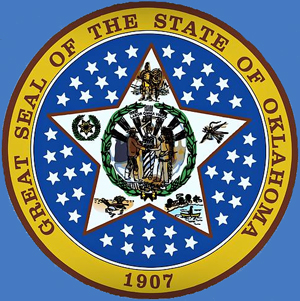 OKLAHOMA CITY – Gross Receipts to the Treasury during the past 12 months, at $12.18 billion, are at an all-time high, State Treasurer Ken Miller announced today. In addition, at $1.1 billion, gross receipts for the month also set a record high for June collections.
OKLAHOMA CITY – Gross Receipts to the Treasury during the past 12 months, at $12.18 billion, are at an all-time high, State Treasurer Ken Miller announced today. In addition, at $1.1 billion, gross receipts for the month also set a record high for June collections.
“It would appear Oklahoma’s economic engine is hitting on all cylinders,” Miller said. “In addition to the revenue picture, leading and lagging economic indicators paint a positive picture for the state’s economy.”
During just completed FY-18, Gross Receipts to the Treasury increased by $1.2 billion, or 11.1 percent, compared to FY-17. Gross receipts for June are up by $86.7 million, or 8.6 percent, compared to June of last year.
 The previous 12-month record high was reached in February 2015 and was set at $12.1 billion. The new record is $73 million higher. The most-recent 12-month low point was reached in March 2017 at $10.76 billion. Since then, 12-month receipts have climbed by $1.4 billion, an increase of 13.1 percent.
The previous 12-month record high was reached in February 2015 and was set at $12.1 billion. The new record is $73 million higher. The most-recent 12-month low point was reached in March 2017 at $10.76 billion. Since then, 12-month receipts have climbed by $1.4 billion, an increase of 13.1 percent.
June marked the 15th consecutive month of positive growth in monthly Gross Receipts to the Treasury compared to the prior year, and 12-month collections have been higher than the previous period for 11 months in a row.
The 12-month report shows growth in all major revenue streams. The report for June collections shows growth in individual and corporate income taxes, along with sales tax and gross production taxes on crude oil and natural gas.
New revenue collections
 The tax commission attributes $33.8 million in June to new revenue resulting from legislation enacted during 2017. The additional revenue comes primarily from changes in sales tax exemptions and gross production tax incentives.
The tax commission attributes $33.8 million in June to new revenue resulting from legislation enacted during 2017. The additional revenue comes primarily from changes in sales tax exemptions and gross production tax incentives.
The new revenue accounts for 3.1 percent of June gross receipts. Out of $11.2 billion in gross collections since last August, $308.5 million, or 2.7 percent, has resulted from last year’s law changes.
Tax increases on cigarettes, fuel and gross production signed into law in late March took effect on July 1 and will have no impact on collections until next month.
Other indicators
The Oklahoma Business Conditions Index, which summarizes several leading economic indicators, has topped growth neutral for 11 consecutive months. The June index slipped to 61.1, from 68.5 in May. Numbers above 50 indicate anticipated economic growth during the next three to six months.

Governor Mary Fallin poses with state, local and tribal officials and executives from Sofidel Group overlooking the future site of an Italian manufacturer’s new plant.
At 4 percent, Oklahoma’s seasonally adjusted unemployment rate remained unchanged in May, while the U.S. jobless rate dropped by one-tenth of a percentage point from April to 3.8 percent. It marks the fourth time since October 1990 and the second consecutive month that Oklahoma’s jobless rate has been higher than the U.S. rate.
June collections
June gross collections total $1.1 billion, up $86.7 million, or 8.6 percent, from June 2017.
Gross income tax collections, a combination of individual and corporate income taxes, generated $389.7million, an increase of $18 million, or 4.8 percent, from the previous June.
Individual income tax collections for the month are $309.4 million, up by $7.1 million, or 2.4 percent, from the prior year. Corporate collections are $80.3 million, an increase of $10.9 million, or 15.7 percent.
Sales tax collections, including remittances on behalf of cities and counties, total $423.1 million in June. That is $49.6 million, or 13.3 percent, more than June 2017.
 Gross production taxes on oil and natural gas generated $68.1 million in June, an increase of $26.4 million, or 63.5 percent, from last June. Compared to May reports, gross production collections are down by $6 million, or 8.1 percent.
Gross production taxes on oil and natural gas generated $68.1 million in June, an increase of $26.4 million, or 63.5 percent, from last June. Compared to May reports, gross production collections are down by $6 million, or 8.1 percent.
Motor vehicle taxes produced $67.5 million, down by $1.8 million, or 2.7 percent, from the same month of 2017.
Other collections, consisting of about 60 different sources including use taxes, along with taxes on fuel, tobacco, and alcoholic beverages, produced $151.1 million during the month. That is $5.5 million, or 3.5 percent, less than last June.
Fiscal Year 2018 collections
Gross revenue totals $12.18 billion during FY-18. That is $1.2 billion, or 11.1 percent, more than collections from the previous fiscal year.
Gross income taxes generated $4.3 billion for the period, reflecting an increase of $334.8 million, or 8.5 percent, from the prior 12 months.
 Individual income tax collections total $3.8 billion, up by $264.7 million, or 7.5 percent, from the prior fiscal year. Corporate collections are $470.8 million for the period, an increase of $70 million, or 17.5 percent, over the previous period.
Individual income tax collections total $3.8 billion, up by $264.7 million, or 7.5 percent, from the prior fiscal year. Corporate collections are $470.8 million for the period, an increase of $70 million, or 17.5 percent, over the previous period.
Sales taxes for the 12 months generated $4.7 billion, an increase of $466.4million, or 11.1 percent, from the prior period.
Oil and gas gross production tax collections brought in $699.9 million during the 12 months, up by $257.2 million, or 58.1 percent, from the previous period.
Motor vehicle collections total $768.7 million for the year. This is an increase of $15.1 million, or 2 percent, from the trailing year.
Other sources generated $1.8 billion, up by $145.5 million, or 9 percent, from the previous fiscal year.
About Gross Receipts to the Treasury
The Office of the State Treasurer has issued the monthly Gross Receipts to the Treasury report since March 2011 to provide a timely and broad view of the state’s macro economy.
 It is released in conjunction with the General Revenue Fund allocation report from the Office of Management and Enterprise Services, which provides important information to state agencies for budgetary planning purposes.
It is released in conjunction with the General Revenue Fund allocation report from the Office of Management and Enterprise Services, which provides important information to state agencies for budgetary planning purposes.
The General Revenue Fund receives less than half of the state’s gross receipts with the remainder paid in rebates and refunds, remitted to cities and counties, and placed into off-the-top earmarks to other state funds.
